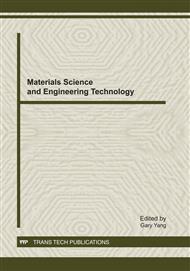p.165
p.169
p.176
p.181
p.185
p.190
p.196
p.202
p.206
The Crystal Growth of Ti50Cu23Ni20Sn7 during the SPS Process
Abstract:
Ti50Cu23Ni20Sn7 bulk amorphous alloy was prepared by mechanical alloying and spark plasma sintering. The milling was performed in a high-energy planetary ball mill. XRD showed that after milled 35h, fully amorphous powders can be obtained, under the condition of the milling speed, 300rpm, and the weighs ratio of ball to powder, 20:1. Thermal stability of the as-milled amorphous powder was determined by DSC at the heating rate of 40K/min. The glass transition Tg and the initial crystallization temperature Tx1 was 746K and 782K, respectively. Then, the obtained amorphous alloy powder was compacted by spark plasma sintering at the temperature of 753K, 763K, 773K, 783K and 793K under the compress of 500Mpa. Crystal structure and the morphology of the sintered samples were investigated by XRD and SEM, respectively. When sintered near the glass transition temperature, the SPS sintered samples remained complete amorphous, crystalline peak did not appear in the XRD curves. As the sintering temperature increased, the crystalline phases in the sample began to increase. It was shown that when sintered at 753K and 763K, the samples had fewer defects, and it was completely amorphous alloy. When the sintering temperature increased to 773K, more defects appeared, including point-like defects and disc-shaped defects. The disc-shaped defect was widespread in the specimens sintered at 783K and 793K.
Info:
Periodical:
Pages:
190-195
Citation:
Online since:
January 2012
Authors:
Keywords:
Price:
Сopyright:
© 2012 Trans Tech Publications Ltd. All Rights Reserved
Share:
Citation:


